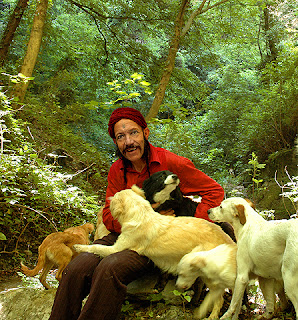 |
| "Gianni Menichetti". Photo (c) Marco Bakker |
There was Gianni Menichetti in Positano, Italy, an artist, poet, and self proclaimed philosopher who lives in a wild Canyon called the Valley of Il Porto with his forty plus dogs (yes, he knows all of their names - I asked), numerous cats, chickens, birds, and other creatures. My friend Claudio brought me to meet Gianni one day, simply telling me in advance, “I think you’ll find him interesting”. It was quite an understatement.
 |
| Il Porto |
 |
| "Gianni Menichetti in his Wild Canyon" (c) Lina Eve |
He had a tattoo in the center of his forehead, eyeliner-esque tattoos outlining his eyes, and a big, bushy black mustache. His hands, too, were covered with henna like tattoos. Perhaps what was most striking about him though were his black sideburns, which hung down past his shoulders, braided with little beads attached at the ends. He reminded me a little of Captain Jack Sparrow.
Gianni spoke perfect English. He told me about his efforts to preserve the canyon, and about fighting the developers who want to come in and destroy his sanctuary. But mainly, he talked about the love of his life: Vali Myers, an artist, dancer, and complete free spirit. He didn’t show me his artwork, but Vali’s. And when I left, he gave me a book he’d written about her.
Check out Gianni here - as I said, fascinating: "His Savage Mistress" http://www.youtube.com/watch?v=tK1tflgkX8A
 |
| Mai and her friend on on hike to the village |
“I used to be poor,” she told us in her broken english. “I didn’t even have any chickens! But now things are going well. My husband and I have our own house and a water buffalo to help us in the rice fields. And soon we’ll have enough money to buy another one.”
It’s amazing the differences in the definition of “poor.”
 |
| Mai's Home |
Mai’s mother and sister were in town visiting, and together we prepared dinner of buffalo meat, tofu, mushrooms, and rice. Mai’s sons were about five, three, and one and were all incredibly polite - the five year old even stuck out his hand and said “nice to meet you” when we first approached.
 |
| Bedroom and kitchen |
Sundays with Jim. Jim Haynes is another bohemian I was fortunate enough to meet when my friend Duc (another intriguing character I met at the Tour de France in 2004) invited me to dinner two Sundays ago.For the past thirty years, Jim has hosted weekly Sunday dinners in his atelier, a former sculpture studio located in the 14th arrondissement. The premise is simple - every Sunday, a different friend prepares a feast, and the first sixty or so people who call or email him are invited. Yes, sixty... although in summer he’s had upwards of one hundred fifty. As Jim puts it, he believes in “introducing people to people.” The dinners are complete melange of age, ethnicity, profession. There’s no formal seating, just a few couches and standing room. It’s all about mingling and making new friends.
 |
| Jim checking the guest list |
 |
| New friends mingling |
Jim has authored a number of books, and I flipped through a few, gaining better insight into his philosophies. “I’ve never worked a day in my life,” begins one of his books (I really liked that philosophy). Another demonstrates his views on formal education by stating "Schooling is not a very subtle way of brainwashing." Jim once edited a series of guidebooks to Eastern Europe and Russia, but rather than fill them with “must see” monuments and museums, he filled them with names - little biographies of people he’d met who had offered to act as guides and welcome travelers to their cities.
As Jim puts it: “Like Tom Paine, I am a world citizen. All human history is mine. My roots cover the earth. I believe we should know each other. After all, our lives are all connected.”
I highly recommend doing dinner at Jim’s for those of you planning a trip to Paris anytime in the near future. It was certainly an unforgettable experience, and one of the best things I’ve done in Paris yet.
Check out Jim’s website here for information on how to get a dinner invite: http://www.jim-haynes.com/


2 comments:
i'm catching up on your blog on saturday morning. I love this one!
Good entry!! Love it.
Post a Comment